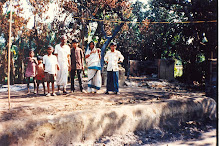AUGUST 15 – INDIAN INDEPENDENCE:
A DAY OF CELEBRATION YET A DAY OF REMEMBRANCE
Sachi G. Dastidar, Ph.D.
(From the Journal of 1st
India Day Parade of Long Island, New York, Long Island India Association and the Federation
of India Associations, U.S.A., pp 104-105; August 11)
On August 15, 1947,
India’s first Prime Minister Jawaharlal Nehru addressed the nation in Delhi, “Long
years ago we made a tryst with destiny, and now the time comes when we shall
redeem our pledge, not wholly or in full measure, but very substantially.
“At the stroke of
midnight hour, when the world sleeps, India will awake to life and freedom. A
moment comes which comes but rarely in history, when we step out from the old
to the new, then an age ends, and when the soul of a nation, long suppressed,
finds utterance. It is fitting that at this solemn moment we take the pledge of
dedication to India and her people and to the still larger cause of humanity.”
While Delhi and most of India rejoiced the Father of the Nation Mahatma Gandhi
was in mourning in Calcutta trying to stop Muslim non-Muslim killing. Before
1947 Gandhiji said that “India will only be partitioned over my dead body” in
opposition to Muslim League’s demand. While he lost his dream of United India Mahatma
succeeded in stopping the carnage in India to the relief of all Indians, but
not in East Bengal which became Muslim-majority East Pakistan or in West Punjab
which became West Pakistan. Muslim League Party’s demand for partition of India
came to fruition with full support and machination of the Colonial British
Administration. In 1947 British policy could have further weakened India but
for the foresights of Sardar Ballav Bhai Patel – the Builder of Modern India. The
1947 division led Pakistan to become a nation where
Hindu-Sikh-Jain-Buddhist-Christian-Parsee minority population came down from
28% in 1947 to a mere 2% today. In Pakistani Kashmir non-Muslims have come down
from 20% to 0%.[1]
In Bangladesh, the former East Pakistan, Hindu population came down from one-third
to less than 10% in 2001 with a loss of over 49 million Hindus from Bangladesh
Census.[2] Today most Pakistani,
Pakistani-Kashmiri, Bangladeshi, and even Afghan, Hindu, Sikh, Jain, Christian,
Buddhists live in India. It may be worthwhile to remember the mindset of
cleansing that began in 1905 with carefully planned Colonial British action.
On October 16, 1905
the British Administration mandated a Muslim-Hindu (non-Muslim) partition of
mixed, tolerant Bengal Province in eastern India when there was no such demand
from either community. In Indian history this date is possibly more profound
than 9/11 for America, but very few in the Subcontinent remember that. From the
mid-1800s Calcutta, the capital of British-India (and Bengal), lead an intense
struggle for Indian independence joined by India’s diverse religious and
linguistic groups. Bengal was then divided between Muslim and non-Muslim, just
as U.P., Punjab and Sind. Colonial ruler Lord Curzon devised a divide-and-rule
policy to create a cleavage among Indians, starting first with Bengal. He created
a majority-Muslim East Bengal Province with extra privileges for “backward
Muslims” and a Hindu-majority (West) Bengal. The British Raj gave huge sums of
money to a non-native Urdu-speaking Muslim landlord, Nawab Salimullah,[3] of Dhaka of East Bengal,
now Bangladesh, to promote an anti-independence Muslim League Party. After an intense effort by mostly-non-Muslim
Indians of the entire Subcontinent the province was reunited in 1912 but that
communal impetus gave rise to intolerant, separatist Islamism.
Muslim-non-Muslim killings became ‘a part of life’ in the Indian Subcontinent.
Success of the first ever use of divide-and-rule policy would make Britain use
that tool later in Asia, Africa, Europe and the Americas. The Islamism that the
British Raj nurtured in India eventually partitioned India and India’s Bengal,
Punjab, Assam provinces, and Kashmir in 1948, giving rise to Islamist Pakistan
and Bangladesh. It dispossessed Hindu Sindhis, Pathans and Balochs.
Effects of India’s
independence continues to this day as we watched on July 23, 2012 “Human
Boundaries” a film by Rahul Raji Nair of Kerala of 151 Pakistani Hindus seeking
shelter in India while India Government’s effort to deport them to Islamic
Republic of Pakistan. Similarly most of us are oblivious of another chapter of
that independence struggle that is unfolding right now in the U.S. In 1971 the
Army of Islamic Republic of Pakistan and its Islamist Bengali allies killed 3
million Bengalis – 90% to 95% Hindus, and rest pro-secular, pro-independence Muslims.
Now some of the mass murderers are being tried in Bangladesh which is being
opposed by pro-Islamists, including many of our congressmen. In the midst of
our celebration, let us extend our hand to those Pakistani Hindus as well as to
the victims of anti-India extremists of 1971 so that they can also join our
celebration. Let us celebrate the ideals of Gandhiji and Subhas Chancra Bose
who sought to create a tolerant, pluralistic, democratic, prosperous India. Jai
Hind.
[1] This is an estimate of the
Princely State of Kashmir based on mountainous Valley region.
[2] See Sachi G. Dastidar, Empire’s Last Casualty: Indian
Subcontinent’s Vanishing Hindu and Other Minorities, Firma KLM Publishers,
Calcutta, India; 2008. In spite of this huge
migration of non-Muslims to India Muslim population of India has risen to 13%
in 2011 from 12% in 1947.
[3] British conferred him “Nawab” to
elevate his status among the Muslims.

No comments:
Post a Comment